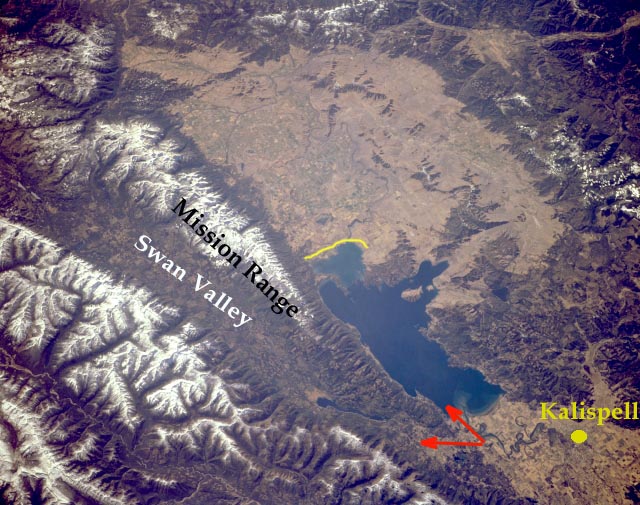|
A
Moraine-Dammed Lake 
The Rocky Mountain Trench . . .
The
Mission Valley lies at the southernmost end of
an impressive feature called "the Rocky
Mountain Trench." The trench, which formed
with the Rocky Mountains roughly 60 million
years ago, extends all the way into the
southern Yukon as a straight, steep valley.
During the last ice age an enormous glacier
filled this trench. As the glacier pushed
southward into this area, the Mission Range
caused it to split ( RED
ARROWS), diverting one branch
into the Swan Valley. Glaciers end when they
reach a point where the climate is warm
enough to melt the front of the ice back at the
same rate it is moving forward. Since the
narrower Swan Valley is more shaded, its
branch flowed 50 miles farther south to the
Clearwater Junction area.
Formation of the moraine dam . . .
Where a glacier ends, the ice melts, dropping
any rock material that was stuck to its bottom
and sides. A ridge formed at the end of a
glacier, called the "end moraine", helps
geologists determine how far the ice
advanced. One such moraine can be found
at Polson. . . If you're driving north on U.S.
Highway 93, you first see Flathead Lake when
you reach the top of this moraine. So, Polson
marks the southernmost extent of the glacier
during the last ice age (15,000 years ago).
As luck would have it . . .
The large size of the Polson Moraine
( YELLOW
LINE) suggests that the ice front
must have remained in that position for quite a
few years. Once the climate began to get
warmer the ice probably melted within a
couple thousand years. Geologists believe
that the part of the glacier in the Mission Valley
survived a few centuries longer than other
parts of the glacier. Had the ice not persisted
there, the present lake basin would have filled
with outwash sediments. Eventually the
stagnant mass of ice also melted, forming a
lake behind the moraine. As soon as the level
of water reached the top of this "moraine
dam", it poured across and began to cut a
channel through it. Usually
"moraine-dammed lakes" are relatively
short-lived because the running water typically
cuts all the way through the moraine and the
lake waters drain away. However, this was
not the fate of the Polson Moraine. By chance
there happened to be a bedrock hill buried
beneath the moraine where the water starting
cutting through the moraine. As a result the
meltwaters did not drain completely, allowing
Flathead Lake to exist today in the valley once
occupied by a glacier.
NOTE: Another moraine near Ronan, called the nine Pipes Moraine,
marks the end of the glacier during a previous
advance.
Source: Alt, David. "The Making of
Flathead Lake" Profiles of Montana
Geology; published by the Montana
Bureau of Mines and Geology in cooperation
with the Montana Magazine 1984
Terms: outwash plain, kettle lake
|






